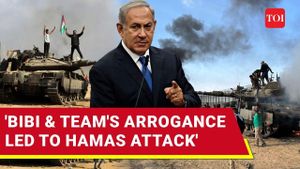Recent global developments have once again raised alarms about the potential for nuclear confrontation as nations ramp up their military capabilities, particularly nuclear arsenals. Tensions rooted in long-standing hostilities have escalated, with players like the United States, Russia, China, Iran, and North Korea at the forefront of this alarming trend.
One of the most pressing concerns revolves around Iran's ambitions to develop nuclear capabilities. On October 26, 2024, after Israel targeted Iranian energy facilities, Iran vowed to respond with "all available tools," igniting widespread fears of weaponization. Current estimates suggest Iran's nuclear breakout time — the duration required to produce a nuclear weapon — could now be as short as weeks. Such developments not only threaten regional stability but could also compel Iran’s adversaries, especially Saudi Arabia, to pursue their own nuclear programs.
Despite recent diplomatic overtures, including China's role as mediator between Iran and Saudi Arabia, these dynamics highlight how fragile the Middle East's nuclear balance is. Diplomacy may play a significant role, yet the potential for conflict looms large over the already tense geopolitical climate.
Meanwhile, the United States continues to modernize its nuclear arsenal, attempting to keep pace with rival powers. Since withdrawing from the Intermediate-Range Nuclear Forces Treaty (INF) in 2019, the U.S. has increased its nuclear capabilities, including plans for deployment across NATO states and bolstering its nuclear umbrella over allies like Taiwan. With Russia enhancing its nuclear posture — evident through expanded military drills and the recent stationing of nuclear weapons in Belarus — the urgency to maintain strategic superiority grows more pressing.
Russia’s movements paint a stark picture of its military intentions. Its suspension of participation in the New Strategic Arms Reduction Treaty (New START) marks the end of arms control's relative stability; it's projected to expire phased out by February 2026. This breakdown suggests the world is facing the specter of unfettered nuclear stockpiling once again, reminiscent of the Cold War era, but now with the addition of China, who has significantly ramped up its nuclear development.
China’s ascendance as an economic powerhouse with military aspirations plays a pivotal role here. It is seen as challenging the U.S.-dominated global order, having already made strides diplomatically and economically through initiatives like the Belt and Road Initiative (BRI). The tension between these global superpowers is palpable, and China’s support of Iran exacerbates existing hostilities, particularly concerning Israel and its allies.
Underlining the complexity are reports of North Korea’s involvement, as it reportedly sends troops to bolster Russia's efforts in Ukraine. This cooperation highlights not only the economic alignment but also the dangerous military partnerships forming between these nations, potentially setting the stage for larger geopolitical conflicts.
Given the intertwined natures of these conflicts, one may wonder how leaders will navigate this perilous terrain. Could diplomacy prevail, or is humanity on the verge of repeating deadly mistakes? Leaders like U.S. President Joe Biden face tremendous pressure to assert dominance without provoking nuclear engagement, which is becoming increasingly difficult.
Past experiences reveal the catastrophic consequences of such brinkmanship — during the peak of the Cold War, leaders strived to control the narrative of nuclear deterrence through treaties, yet the proliferation of armaments continues to signify the fragility of peace. A stark reminder is the nuclear arms race of the mid-20th century, when aggressive posturing by both the U.S. and the Soviet Union led to the stockpile of tens of thousands of nuclear warheads, with the treaties later slashing those numbers significantly.
Efforts at arms control have dwindled, and many treaties established to curb the nuclear ambitions of states lie obsolete, creating conditions ripe for another potentially catastrophic arms race. "A nuclear war cannot be won," former U.S. President Ronald Reagan stated back during the Cold War. Today, this statement is still painfully relevant. The reintroduction of strategic arms race rhetoric, particularly involving advanced technologies such as cyber weapons and AI, adds layers of potential ambiguity and instability.
Counteracting these threats requires significantly collaborative diplomatic efforts among nuclear-armed nations, yet current geopolitical realities reveal cooperation to be increasingly difficult. The high stakes involved — economic interests, territorial integrity, and political sovereignty — complicate the situation even more and must be handled delicately to prevent miscalculations.
Lastly, public sentiment and pressure on governments to bolster security through military might can also sway leaders to pursue aggressive arms strategies, amplifying existing tensions. While the predominant concern remains actual conflict and its nuclear ramifications, proactive measures involving dialogue and engagement could help de-escalate the situation.
The current state of nuclear geopolitics paints a dire picture but also presents opportunities for renewed diplomatic engagement. Cooperation can yield positive outcomes, yet the hesitation among world leaders to relinquish obsolete power structures and exhibit transparency poses significant barriers to progress. The time for collective action is now; the question remains whether global leaders can muster the political will to avert disaster.



